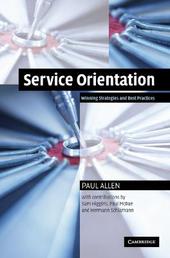
|
Service Orientation: Winning Strategies and Best Practices
Hardback
Main Details
| Title |
Service Orientation: Winning Strategies and Best Practices
|
| Authors and Contributors |
By (author) Paul Allen
|
|
Contributions by Sam Higgins
|
|
Contributions by Paul McRae
|
|
Contributions by Hermann Schlamann
|
| Physical Properties |
| Format:Hardback | | Pages:360 | | Dimensions(mm): Height 254,Width 180 |
|
| Category/Genre | Business mathematics and systems |
|---|
| ISBN/Barcode |
9780521843362
|
| Classifications | Dewey:658.5 |
|---|
| Audience | | Professional & Vocational | |
|---|
| Illustrations |
53 Tables, unspecified; 102 Line drawings, unspecified
|
|
Publishing Details |
| Publisher |
Cambridge University Press
|
| Imprint |
Cambridge University Press
|
| Publication Date |
13 April 2006 |
| Publication Country |
United Kingdom
|
Description
Companies face major challenges as they seek to flourish in competitive global markets, fuelled by developments in technology, from the Internet to grid computing and Web services. In this environment, service orientation - aligning business processes to the changing demands of customers - is emerging as a highly effective approach to increasing efficiency. In this book, Paul Allen provides an accessible guide to service orientation, showing how it works and highlighting the benefits it can deliver. The book provides an integrated approach: after covering the basics of service orientation, he discusses key issues such as business agility, designing quality-of-service infrastructure, implementing service-level agreements, and cultural factors. He provides roadmaps, definitions, templates, techniques, process patterns and checklists to help you realize service orientation. These resources are reinforced with detailed case studies, from the transport and banking sectors. Packed with valuable insights, the book will be essential reading for CIOs, IT architects and senior developers. IT facing business executives will also benefit from understanding how software services can enable their business strategies. Paul Allen is a principal business-IT strategist at CA and is widely recognized for his innovative work in component-based development (CBD), business-IT alignment and service-oriented architecture. With over thirty years experience of large-scale business systems, he is an established author whose previous book was the critically acclaimed Realizing e-Business with Components. Sam Higgins is now with Forrester Research Inc.; formerly he managed the Innovation and Planning Unit of Queensland Transport's Information Services Branch. Paul McRae is the application architect in the Innovation and Planning Unit of Queensland Transport's Information Services Branch. Hermann Schlamann is a senior architect in the architecture group of Credit Suisse.
Author Biography
Paul Allen is a principal business-IT strategist at CA and is widely recognized for his innovative work in component-based development (CBD), business-IT alignment and service-oriented architecture. With over thirty years experience of large-scale business systems, he is an established author whose previous book was the critically acclaimed Realizing e-Business with Components. Sam Higgins is now with Forrester Research Inc.; formerly he managed the Innovation and Planning Unit of Queensland Transport's Information Services Branch. Paul McRae is the application architect in the Innovation and Planning Unit of Queensland Transport's Information Services Branch. Hermann Schlamann is a senior architect in the architecture group of Credit Suisse.
Reviews'For the last 40 years, business has viewed IT as its principal tool to increase productivity, and rightly so. Industries as diverse as retailing and financial services have been transformed by technology, especially when used in a networked way. Yet very often, IT has constrained the evolution of those business processes by imposing rigid technology implementations on them. And even worse, as IT has grown and become more important, it has become more complex and difficult to manage, especially in larger enterprises. In some cases the sheer complexity of the IT environment has started to limit the ability of companies to innovate. However, as Paul Allen shows, recent advances in IT processes and technologies, especially service-oriented architectures are starting to free companies up from these constraints, and allow them to once again align their IT processes in support of their business processes. Service Orientation: Winning Strategies and Best Practices charts the course for handling what promises to be as profound a change to IT as any that has occurred in the last few decades.' John A Swainson, President and CEO, CA
|